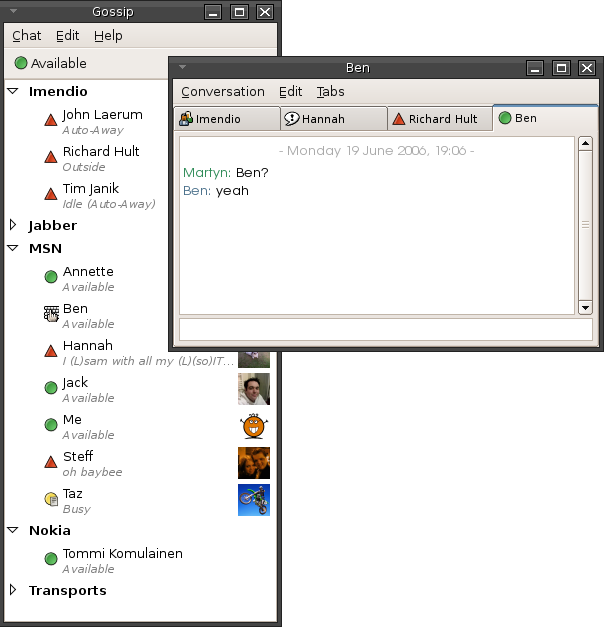|
OSCAR Protocol
Open System for Communication in Realtime (OSCAR) is AOL's proprietary instant messaging and presence information protocol. It was used by AOL's AIM instant messaging system and ICQ. Despite its name, the specifications for the protocol remain proprietary. AOL has gone to great lengths to keep competitors (namely Microsoft, XMPP, and Cerulean Studios) from implementing compatible clients for their proprietary messaging systems. In 2002, AOL signed a contract with Apple, Inc., allowing them to use OSCAR (as well as AOL's own code libraries) in their iChat application. This allowed iChat users to interact with ICQ and AIM users directly. The deal also permitted users of Apple's .Mac service to log in to the AIM network using their .Mac email addresses. (This has carried over to Apple's MobileMe service.) , large parts of the protocol had been reverse-engineered and implemented by a number of third-party clients. The OSCAR protocol can be used separately from AOL's network. In ... [...More Info...] [...Related Items...] OR: [Wikipedia] [Google] [Baidu] [Amazon] |
|
 |
Instant Messaging
Instant messaging (IM) technology is a type of synchronous computer-mediated communication involving the immediate ( real-time) transmission of messages between two or more parties over the Internet or another computer network. Originally involving simple text message exchanges, modern IM applications and services (also called "social messengers", "messaging apps", "chat apps" or "chat clients") tend to also feature the exchange of multimedia, emojis, file transfer, VoIP (voice calling), and video chat capabilities. Instant messaging systems facilitate connections between specified known users (often using a contact list also known as a "buddy list" or "friend list") or in chat rooms, and can be standalone apps or integrated into a wider social media platform, or in a website where it can, for instance, be used for conversational commerce. Originally the term "instant messaging" was distinguished from " text messaging" by being run on a computer network instead of a cellula ... [...More Info...] [...Related Items...] OR: [Wikipedia] [Google] [Baidu] [Amazon] |
|
Comparison Of Instant Messaging Clients
The landscape for instant messaging involves cross-platform instant messaging clients that can handle one or multiple protocols. Clients that use the same protocol can typically federate and talk to one another. The following table compares general and technical information for cross-platform instant messaging clients in active development, each of which have their own article that provide further information. __TOC__ General Operating system support Connectivity Privacy Some messaging services that are not designed for privacy require a unique phone number for sign-up, as a form of identity verification and to prevent users from creating multiple accounts. Some messaging services that do not solely focus on a mobile-first experience, or enforce SMS authentication, may allow email addresses to be used for sign-up instead. Some messaging services offer greater flexibility and privacy, by allowing users to create more than one account to compartmentalize personal ... [...More Info...] [...Related Items...] OR: [Wikipedia] [Google] [Baidu] [Amazon] |
|
|
Perl
Perl is a high-level, general-purpose, interpreted, dynamic programming language. Though Perl is not officially an acronym, there are various backronyms in use, including "Practical Extraction and Reporting Language". Perl was developed by Larry Wall in 1987 as a general-purpose Unix scripting language to make report processing easier. Since then, it has undergone many changes and revisions. Perl originally was not capitalized and the name was changed to being capitalized by the time Perl 4 was released. The latest release is Perl 5, first released in 1994. From 2000 to October 2019 a sixth version of Perl was in development; the sixth version's name was changed to Raku. Both languages continue to be developed independently by different development teams which liberally borrow ideas from each other. Perl borrows features from other programming languages including C, sh, AWK, and sed. It provides text processing facilities without the arbitrary data-length limits of ... [...More Info...] [...Related Items...] OR: [Wikipedia] [Google] [Baidu] [Amazon] |
|
 |
Python (programming Language)
Python is a high-level programming language, high-level, general-purpose programming language. Its design philosophy emphasizes code readability with the use of significant indentation. Python is type system#DYNAMIC, dynamically type-checked and garbage collection (computer science), garbage-collected. It supports multiple programming paradigms, including structured programming, structured (particularly procedural programming, procedural), object-oriented and functional programming. It is often described as a "batteries included" language due to its comprehensive standard library. Guido van Rossum began working on Python in the late 1980s as a successor to the ABC (programming language), ABC programming language, and he first released it in 1991 as Python 0.9.0. Python 2.0 was released in 2000. Python 3.0, released in 2008, was a major revision not completely backward-compatible with earlier versions. Python 2.7.18, released in 2020, was the last release of ... [...More Info...] [...Related Items...] OR: [Wikipedia] [Google] [Baidu] [Amazon] |
 |
OCaml
OCaml ( , formerly Objective Caml) is a General-purpose programming language, general-purpose, High-level programming language, high-level, Comparison of multi-paradigm programming languages, multi-paradigm programming language which extends the Caml dialect of ML (programming language), ML with Object-oriented programming, object-oriented features. OCaml was created in 1996 by Xavier Leroy, Jérôme Vouillon, Damien Doligez, Didier Rémy, Ascánder Suárez, and others. The OCaml toolchain includes an interactive top-level Interpreter (computing), interpreter, a bytecode compiler, an optimizing native code compiler, a reversible debugger, and a package managerOPAM together with a composable build system for OCamlDune. OCaml was initially developed in the context of automated theorem proving, and is used in static program analysis, static analysis and formal methods software. Beyond these areas, it has found use in systems programming, web development, and specific financial utili ... [...More Info...] [...Related Items...] OR: [Wikipedia] [Google] [Baidu] [Amazon] |
|
Objective-C
Objective-C is a high-level general-purpose, object-oriented programming language that adds Smalltalk-style message passing (messaging) to the C programming language. Originally developed by Brad Cox and Tom Love in the early 1980s, it was selected by NeXT for its NeXTSTEP operating system. Due to Apple macOS’s direct lineage from NeXTSTEP, Objective-C was the standard language used, supported, and promoted by Apple for developing macOS and iOS applications (via their respective application programming interfaces ( APIs), Cocoa and Cocoa Touch) from 1997, when Apple purchased NeXT until the introduction of the Swift language in 2014. Objective-C programs developed for non-Apple operating systems or that are not dependent on Apple's APIs may also be compiled for any platform supported by GNU GNU Compiler Collection (GCC) or LLVM/ Clang. Objective-C source code 'messaging/implementation' program files usually have filename extensions, while Objective-C 'header/ ... [...More Info...] [...Related Items...] OR: [Wikipedia] [Google] [Baidu] [Amazon] |
|
 |
Java (programming Language)
Java is a High-level programming language, high-level, General-purpose programming language, general-purpose, Memory safety, memory-safe, object-oriented programming, object-oriented programming language. It is intended to let programmers ''write once, run anywhere'' (Write once, run anywhere, WORA), meaning that compiler, compiled Java code can run on all platforms that support Java without the need to recompile. Java applications are typically compiled to Java bytecode, bytecode that can run on any Java virtual machine (JVM) regardless of the underlying computer architecture. The syntax (programming languages), syntax of Java is similar to C (programming language), C and C++, but has fewer low-level programming language, low-level facilities than either of them. The Java runtime provides dynamic capabilities (such as Reflective programming, reflection and runtime code modification) that are typically not available in traditional compiled languages. Java gained popularity sh ... [...More Info...] [...Related Items...] OR: [Wikipedia] [Google] [Baidu] [Amazon] |
 |
Go (programming Language)
Go is a high-level programming language, high-level general purpose programming language that is static typing, statically typed and compiled language, compiled. It is known for the simplicity of its syntax and the efficiency of development that it enables by the inclusion of a large standard library supplying many needs for common projects. It was designed at Google in 2007 by Robert Griesemer, Rob Pike, and Ken Thompson, and publicly announced in November of 2009. It is syntax (programming languages), syntactically similar to C (programming language), C, but also has memory safety, garbage collection (computer science), garbage collection, structural type system, structural typing, and communicating sequential processes, CSP-style concurrency (computer science), concurrency. It is often referred to as Golang to avoid ambiguity and because of its former domain name, golang.org, but its proper name is Go. There are two major implementations: * The original, Self-hosting (compi ... [...More Info...] [...Related Items...] OR: [Wikipedia] [Google] [Baidu] [Amazon] |
|
C Sharp (programming Language)
C# ( pronounced: C-sharp) ( ) is a general-purpose high-level programming language supporting multiple paradigms. C# encompasses static typing, strong typing, lexically scoped, imperative, declarative, functional, generic, object-oriented (class-based), and component-oriented programming disciplines. The principal inventors of the C# programming language were Anders Hejlsberg, Scott Wiltamuth, and Peter Golde from Microsoft. It was first widely distributed in July 2000 and was later approved as an international standard by Ecma (ECMA-334) in 2002 and ISO/ IEC (ISO/IEC 23270 and 20619) in 2003. Microsoft introduced C# along with .NET Framework and Microsoft Visual Studio, both of which are technically speaking, closed-source. At the time, Microsoft had no open-source products. Four years later, in 2004, a free and open-source project called Microsoft Mono began, providing a cross-platform compiler and runtime environment for the C# programming language. A decad ... [...More Info...] [...Related Items...] OR: [Wikipedia] [Google] [Baidu] [Amazon] |
|
 |
C (programming Language)
C (''pronounced'' '' – like the letter c'') is a general-purpose programming language. It was created in the 1970s by Dennis Ritchie and remains very widely used and influential. By design, C's features cleanly reflect the capabilities of the targeted Central processing unit, CPUs. It has found lasting use in operating systems code (especially in Kernel (operating system), kernels), device drivers, and protocol stacks, but its use in application software has been decreasing. C is commonly used on computer architectures that range from the largest supercomputers to the smallest microcontrollers and embedded systems. A successor to the programming language B (programming language), B, C was originally developed at Bell Labs by Ritchie between 1972 and 1973 to construct utilities running on Unix. It was applied to re-implementing the kernel of the Unix operating system. During the 1980s, C gradually gained popularity. It has become one of the most widely used programming langu ... [...More Info...] [...Related Items...] OR: [Wikipedia] [Google] [Baidu] [Amazon] |
 |
Programming Language
A programming language is a system of notation for writing computer programs. Programming languages are described in terms of their Syntax (programming languages), syntax (form) and semantics (computer science), semantics (meaning), usually defined by a formal language. Languages usually provide features such as a type system, Variable (computer science), variables, and mechanisms for Exception handling (programming), error handling. An Programming language implementation, implementation of a programming language is required in order to Execution (computing), execute programs, namely an Interpreter (computing), interpreter or a compiler. An interpreter directly executes the source code, while a compiler produces an executable program. Computer architecture has strongly influenced the design of programming languages, with the most common type (imperative languages—which implement operations in a specified order) developed to perform well on the popular von Neumann architecture. ... [...More Info...] [...Related Items...] OR: [Wikipedia] [Google] [Baidu] [Amazon] |